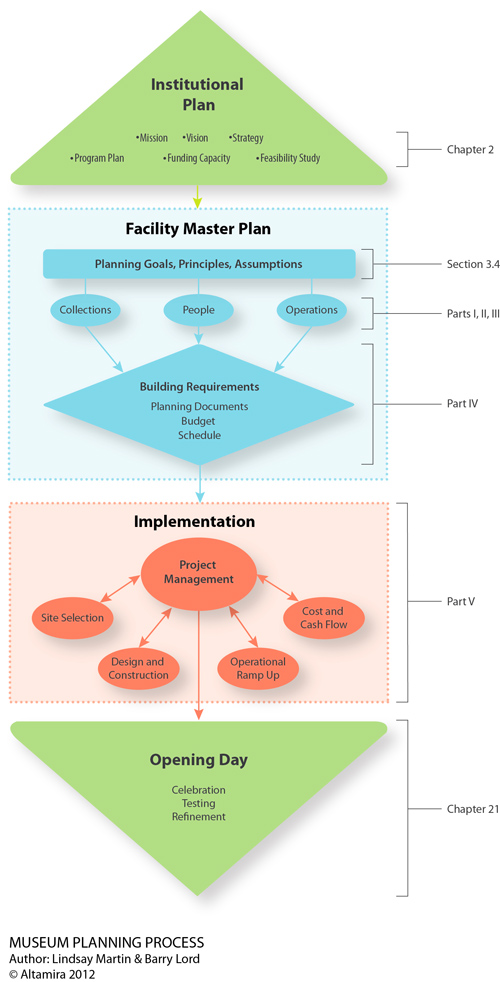Planning for Museums
Owing to their role as a reflection of community and means of communication, museums are constantly in flux. Indeed, the standards of museum building and management have advanced substantially, and, as a result, the expectations for implementing sustainable museums practices are high. Thus the third edition of The Manual of Museum Planning provides a welcomed—and well needed—examination of how to plan for and create a sustainable museum in the 21st Century. Updated and expanded in order to meet the ever-evolving expectations of museums today, the Manual contains five primary sections—Planning for People, Planning for Collections, Planning for Operations, Planning for the Building, and Implementation—each of which presents significant contributions by leaders in the field. This new edition strives to encourage planning that is sustainable in all aspects by means of the quadruple bottom line: social, environmental, economic, and cultural sustainability.
Museums achieve social sustainability through their constant effort to remain a relevant, contributing, and vital member of a society. Environmental sustainability acts as an important component of the quadruple bottom line—museums obtain this through constant dialogue and discussion, educating the public, and exemplifying best practices. Museums achieve economic sustainability by spending money wisely, which maintains public, donor, and governmental trust. Ensuring long-term impact within the culture of the museum’s community—whether local, regional, national, or global—enables a museum to achieve cultural sustainability.
The new edition presents a useful explanation of sustainable museum planning practices to all those involved with the planning, design, and provision of museums. The museum planning process, which will never be easy, is made accessible by the Manual as the editors have effectively assembled the sections and sub-sections of the publication with a logical, systematic approach in mind.
Museum planning is not a linear process. Rather, museum planning is a process in which initial principles, guidelines, and prior decisions will continually need to be revised in order to effectively move forward toward opening day. It is our hope at Lord Cultural Resources that this latest edition sheds new light on the museum planning process.
There are five primary sections in the Manual that detail the planning process:
 |
- Part I, Planning for People, demonstrates that museums may seem to be about objects but they are truly about people. In fact, a sustainable museum serves as a culturally sensitive entity within its community. This section examines the dynamic between a museum and its community—local or global. Further, this section details the various roles that a museum must take on in order to effectively advance as a sustainable institution. Planning for people is part and parcel of a museum’s obligation to communicate and interpret its collections, the collections of others, and their global role. The various capacities that a museum must take on are detailed in this section: collectors, mediators, presenters, sources of wonder and beauty, builders, patrons, promoters, and placemakers.
- Part II, Planning for Collections, demonstrates how and why collections serve as the fundamental backbone of a museum. Accounting and planning for collections as well as their short as well as long-term care is critical, in fact central, to the museum planning discipline. This section provides readers with a concise introduction to quantitative and qualitative collection analysis. The utilization of collections in long-term as well as temporary exhibitions and their resulting need for management, storage, documentation, conservation, and research serves as a primary topic in this section. This section also presents readers with an examination of the controlled dynamics of the museum environment and preventative conservation measures, which must be planned for so their preservation will have an indefinite future.
- While museum planners tend to not give due diligence to planning for museum operations, Part III not only provides a highly informative explanation of operations, but asserts and ably demonstrates that museum operations are necessary in order to deliver on the mission and have substantial influence on the visitor experience and perception of the museum. Accounting for what staff will be needed, what will be the full range of programs that the museum facility must support, how will visitors and staff move throughout the museum space, how much will it all cost and where will the funding come from, are just some of the essential questions that this section addresses.
- Part IV acts as a critical part of the book as it utilizes the preceding three parts of the Manual and their respective content as a way to link them to the final product of the museum planning process: the Facility Strategy and Functional Program—or Brief—for the proposed capital project. Part IV provides an explanation of the contents of these planning documents and demonstrates the ways in which they can be applied in the eventual design development process. Later chapters in Part IV emphasize the importance of preparing these documents with regard to issues of environmental sustainability—a fundamental theme of this edition of the Manual. Lastly, this section provides a clear explanation of the need for full funding capabilities when planning for a museum or project of any kind.
- Part V, Implementation, serves as a culminating section in which the planning issue of the four previous sections—and their implementation—are explained in detail. It provides a thoughtful explanation of project management and its importance throughout the entire museum planning process as well as highlights issues of site selection and sound architectural and engineering plans. The last chapter in this section provides an explanation of monitoring and controlling cash flow while there will be the concurrent need to hire and train staff in order to prepare the museum for opening day.
|
|

